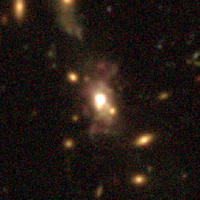Green bean galaxy facts for kids
Green Bean Galaxies (GBGs) are very rare and fascinating objects found in space. Scientists believe they are like "light echoes" or "ghosts" of super-bright objects called quasars that were once very active. Imagine a powerful flashlight that was on for a short time and then turned off. Even after it's off, its light continues to travel, making things glow as it passes by. Green Bean Galaxies are similar; they glow because of light from a powerful event that happened in their past.
These unique galaxies were discovered by a team of scientists led by Mischa Schirmer. They found that GBGs are a type of Seyfert galaxy that have incredibly bright, glowing gas clouds spread throughout them. These glowing regions are much larger than the galaxy's main body.
Contents
What Are Green Bean Galaxies?
The discovery of Green Bean Galaxies happened when scientists were looking at images from the 3.6-meter Canada–France–Hawaii Telescope in Hawaii. Mischa Schirmer noticed a galaxy with very unusual colors. It was especially bright in a specific color filter, which suggested it was giving off a lot of light at a particular wavelength.
Its color reminded him of "Green Pea galaxies", which are small, compact galaxies where many new stars are forming. However, the object that became known as a Green Bean Galaxy was much, much larger than any Green Pea galaxy. This led to its nickname, "GBG," because of its green color and its resemblance to, but larger size than, Green Pea galaxies.
Why Are They So Special?
Green Bean Galaxies are incredibly rare. On average, you might only find one in a huge cube of space about 1.3 billion light-years across! This rarity tells us that whatever causes them to glow is either a very unusual event or lasts for only a very short time.
In most Green Pea galaxies, the gas glows because of strong UV-light from many new stars being born. But in Green Bean Galaxies, the gas glows because of powerful x-rays coming from a supermassive black hole at their center. This active black hole is called an "active galactic nucleus" (AGN). The X-rays from this AGN make the gas in the galaxy glow brightly.
GBGs are likely related to another famous space object called Hanny's Voorwerp. Hanny's Voorwerp is also thought to be a "light echo" from a quasar. However, Green Bean Galaxies are much bigger and brighter. They have 10 to 100 times more glowing gas than other similar objects. Scientists estimate that these glowing "echoes" can last for tens of thousands to hundreds of thousands of years.
How Do They Form?
Scientists are still studying exactly how Green Bean Galaxies form. It's thought that the huge clouds of gas that glow so brightly were pushed out during the final stages of a super-bright quasar's life. A quasar is a galaxy with a supermassive black hole at its center that is actively "feeding" and shooting out huge amounts of energy.
After this super-bright phase, the quasar might have quickly "shut down" or become much less active. Even after it shuts down, the powerful X-rays from its past active state can still travel through space. When these X-rays hit the gas clouds, they make the gas glow. This is what scientists call an "ionization echo." It's like seeing the lingering glow from a powerful flash that happened long ago.
What We Learn from Green Bean Galaxies
Scientists study Green Bean Galaxies because they offer a unique look into the past of super-luminous quasars. By observing these glowing echoes, researchers can learn how the most powerful quasars transform into less active ones. GBGs act like "fossil records" of these dramatic changes in galaxies.
These galaxies also help scientists understand how the activity of a central black hole can affect the gas and stars in the rest of its galaxy. Because Green Bean Galaxies are relatively close to us and very bright, they are excellent targets for studying these powerful processes in the universe. They help us understand how galaxies evolve over billions of years.
Images for kids
See also
- Pea galaxy
- Galactic orientation
- Galaxy formation and evolution




